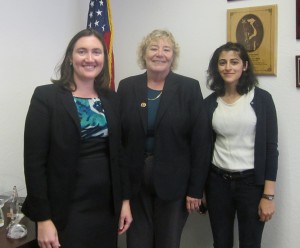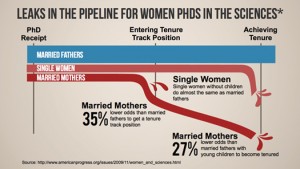Last week a SJSU student from my lab, Anusha Allawala, and I had the opportunity to meet with Congresswoman Zoe Lofgren and a staff member at her San Jose District office. Members of Congress spend the summer recess in their home districts and unless you live near DC this is often the easiest time to meet with them in person. I had no idea how accessible elected officials actually are until this past year. Members of Congress and their staff spend a large portion of their time meeting with and listening to their constituents and this is one way that you can help ensure that the issue you are passionate about is on their radar. To set up this meeting I emailed the staffer in charge of scheduling (you can find this online or ask your professional society’s advocacy office for help). Even though I waited until early August when her schedule was already full to request the meeting, I was offered a cancellation spot and was still able to get a 20 minute meeting.
Katie Wilkinson, Representative Lofgren, and Anusha Allawala
Here are 3 reasons why you should meet with your elected officials:
1) You can give your elected officials a personal story to illustrate the effect of policies in Washington.
It is human nature to relate more easily to an individual’s tragedy than dry numbers. The decrease in science funding has had tremendous effects across the board, but you can help your elected officials understand what it means in their district. I asked Anusha to join the meeting because she is currently supported by the US Department of Education’s McNair Scholars Program, which provides mentorship and funding to low income first generation college students and/or students from underrepresented groups interested in PhD programs. In the past few years the budget for this program, and many similar programs, has been cut drastically. Now McNair Scholars can only receive one year of support instead of two and there is no budget for research supplies. Anusha was able to tell the Congresswoman how important this program has been in helping prepare her for graduate school, especially since she is a recent immigrant and first generation college student. As Congresswoman Lofgren was also a first generation college student you could tell that she really connected with Anusha’s story and the importance of these federally funded training programs. Perhaps Anusha’s story (or yours) will end up in a speech someday.
2) You can thank your elected official for their support of your issue and encourage their continued support.
In the Bay Area, we are lucky to be represented by people who understand the value of science funding and typically support increased levels of funding. I was told that one of the reasons I was offered first chance at the cancellation spot was that Representative Lofgren is very supportive of science and especially women in science. Even though the Congresswoman has signed Dear Colleague letters in support of increased NIH and NSF funding this year it is still important to make sure that she is thanked for her support and reminded that science funding is valued by constituents and institutions in her district. If your elected official is not in support of your issue, an in person meeting has the potential to change their mind.
3) You can offer yourself as a resource to make sure that accurate science is used in making public policy.
In my preparation for the meeting I learned that Representative Lofgren introduced the Zs to As Act in 1998 that would have pushed high school start times later to align with what we know about the adolescent circadian rhythm (sadly the bill never passed). This is a great example of public policy based on science and at our meeting Representative Lofgren told us she had consulted with sleep specialists at Stanford while she was drafting the bill. Scientists are in the perfect position to offer their expertise or network of knowledgeable colleagues to help develop scientifically sound public policy. Most professional societies have an advocacy office that can help you put your elected officials in contact with relevant experts.
Hopefully now you are convinced to set up a meeting with your members of Congress. Please feel free to contact me if you have any questions about logistics.

